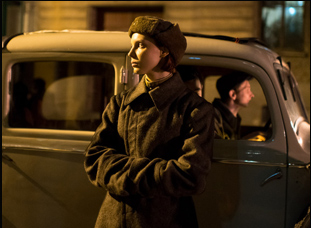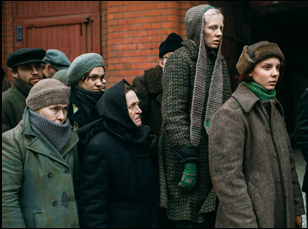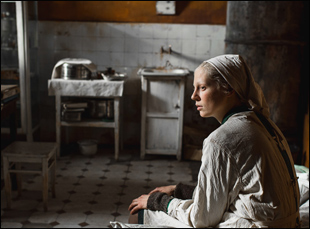There’s something strangely beautiful about the fact that Kantemir Balagov can’t exactly find the right word in English to describe the impetus to become a filmmaker. He doesn’t rely almost at all on the translator to his left during our interview on a rooftop in Toronto, but in this instance, he decides to confer with the intepreter, who’s at something at a loss as well, though this seems apt for a filmmaker whose work is somewhat difficult to describe.
“It’s a hard word even in Russia,” Balagov says with a slight laugh. “It came from a self-search, a search of self-realization because I tried to find what I was interested in and it was so difficult for me, especially from the region where I came from. There’s no cinema, there’s nothing. So my father bought a [still] camera for me with a video function and wanted me to shoot the weddings to make some money because each week, there’s five, 10 weddings.”
Balagov didn’t attend many nuptials, instead putting the camera to use with odds and ends that he’d put on YouTube, which were intriguing enough for a friend to tell him he should write to Alexandr Sokurov, the living legend who had opened a film foundation to support burgeoning filmmakers. A letter back inviting him to study at his studio made the filmmaker feel as if he had just gotten married.
”I was like, ‘Oh my God,’” says Balagov. ”It’s incredible how lucky I am.”
The directing prodigy has shown in the years since that there was far more than luck involved when at 26, his debut feature “Closeness” made waves at the Cannes Film Festival, paving the way for a return two years later with his latest film “Beanpole,” a bewitching drama set after the devastation of World War II in Russia. One need only look at the hospital where Iya (Viktoria Miroshnichenko) works as a nurse to see the toll it’s taken as soldiers lie on gurneys, blooded and often without a few of the limbs they went into battle with. Nicknamed “Beanpole” for her imposing physique, Iya is nearly as impaired as any of the men she tends to, conscious of towering over them and suffering from a mysterious condition that will put her into a trance as a moment’s notice, dismissed by co-workers as drifting off into space. Naturally, this makes her an less than ideal choice of babysitter for her friend Masha (Vasilisa Perelygina), who is still in combat and leaves Iya with her young son Pashka.
When tragedy strikes and Masha returns home to find that the one thing she had left in the world that she could call her own is gone, Balagov untwists the knots of the tortured relationship between the two women as they know they only have one another to depend on, in spite of the great pain they’ve inflicted on each other, and the loss of a child is sublimated into the host of new realities they encounter in a society that’s been completely upended. In a world that now seems unreal, the writer/director brings a style of storytelling reminiscent of Guillermo del Toro’s Spanish Civil War films such as “The Devil’s Backbone” and “Pan’s Labyrinth,” finding that some light fantastical touches are necessary to convey an unfathomable history, yet uniquely gets at how broken spiritually and physically Iya and Masha have become and why their bond persists even when they serve as reminders of the past.
Recently when Balagov attended the Toronto Film Festival en route to the New York Film Festival where “Beanpole” will bow this weekend, the filmmaker spoke about teaming with “Leviathan” and “Loveless” producer Alexander Rodnyansky to get this unique drama off the ground, creating its immersive and authentic ambiance and what he learned from previsualizing the film.
I was studying in Alexander Sokorov’s studio and I read news that Svetlana Alexievich got a Nobel Prize for “The Unwomanly Face of War” in 2015, so I got interested. When I read it, I got obsessed with it because I realized I knew nothing [from the perspective of] the women in the war, about the physical shift in their body and their mindset. I just gave to myself a word that I will make a film about it because in modern cinema, no one shows a woman’s fate after the war because almost every time it’s about men and their courage, etc, but [I felt an obligation] not only as a director, but as a citizen and as a human being too. My inspiration in the cinema was Larisa Shepitko, [who did] “Wings,” one of these films about women after the war and Aleksei German, so I just knew that I wanted to make a story about it. Right after I shot “Closeness,” my first film, and [we premiered at] Cannes, I started to write the script and and I just sent to Alexander Rodnyansky the short synopsis of the story and he said, “Yeah, I’m in it. Let’s go. Let’s do it.” And from that, we started to work with each other.
Was it exciting or intimidating to approach a period film?
It was exciting, but on the other hand, it was so exhausting because you’re almost in research mode 24/7. You’re always trying to find something interesting to pay attention to, and to not mess the things up when you should have only this kind of chair or table in the frame because it was so important for me to respect the reality of that. But with the help of colors, I wanted to be on level higher than reality because while I was [doing] the research, I found that people at those times tried to escape from reality with the help of [vibrant] colors. They surrounded themselves to help distract [from] the situation [they were in] and I knew that each person has his unique color and there would be a dramaturgical dynamic or stagnation [with the color], depending on the character or the scene. It’s one of the layers of the film and why the film looks like that in this way.
And you found real locations to film in. Was it difficult to locate those places to shoot?
No, fortunately, because in St. Petersburg, the architecture of the city hasn’t changed so much. It was important to shoot the film in real spaces because it’s history. You can feel it in the air, how the floor sounds or the doors open – these kind of things. That’s also why I wanted to not rerecord the sound of the film [in post-production]. This is the sound from the shooting. There’s only one space, the bath scene, which was recreated, but all the other spaces were real buildings.

That was funny because it was the first day of the casting and they came both at the same time, so I was like, “Wow, that’s a sign.” You never expect that and in “Closeness,” it was much harder than with “Beanpole,” so we just had them talk to each other, had some rehearsals and I knew from the first time, those are my characters.
Was there anything you saw in the rehearsals that made you rethink the film?
There’s not so many things that were added because of the rehearsals, because at the rehearsals, we tried to understand the characters’ motivations, not to add something new. We’re trying to recreate the person that lived some day, not to make actresses play the characters – they’re different things. But we did a preshoot [where] we took a camera, we took the actresses and shot the whole film. That was helpful for me because I changed the rhythm of some scenes, like the first appearance of Masha. In preshoot, [there were] going to be so many cuts in editing and after rehearsal, I understood, I don’t have a right to interrupt her life in frame with a cut. This should be one take because during this scene, she understands that her child is dead and as a director and as a human being, this exact time when she understands things Is much more interesting to me [in an unbroken take] because cuts always [suggest] some kind of point of view, and I didn’t have a right to show the audience that you should be at this side at this moment.
It reminded me of no less than Sokurov’s “Russian Ark” in that sense.
Well, thank you. But I don’t know if Alexandr Sokurov would like this commentary. [laughs] No, I really like long takes because as an audience you can feel more close to the character because you’re spending more time with them without these cuts, but it depends on the scene. In my first one [“Closeness”], there’s no such long takes like in “Beanpole” and it was challenging for me, but I wanted to create something with another rhythm so I don’t repeat myself.

That’s an important scene for me because it came from personal diaries [in my research]. I was so moved when I read that women went to the war around 18 years old and they return 23, 24, somewhat older, and I remember that some of them said it was so unusual when you [take off] your army jacket, army pants and army boots and you try to get used to the dresses. It’s like they’re trying to walk from [birth]. So this scene for me is like a loss of youth because these young women had no youth. They went to war and each turn Masha does [on the dance floor] she’s like wanting to grab this youth, wanting to remember it, but each turn shows her it’s impossible to fill that void.
What’s it been like to take this around the world?
It’s great because it allows you to discover yourself in some way. It’s my first time in Toronto and I’ve been in Telluride a few weeks ago [for the first time] and I will go to New York, so I meet people, I try to find something common between us and it’s been really interesting for me.
“Beanpole” will screen at the New York Film Festival at Alice Tully Hall on October 6th at 9 pm and Walter Reade Theater on October 8th at 9 pm. It will be distributed by Kino Lorber in 2020, beginning with a theatrical run at Film Forum in New York on January 29th.




